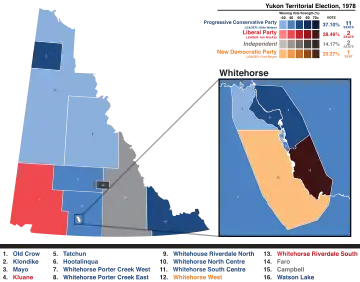1978 Yukon general election
The 1978 Yukon general election (28th general election), held on November 20, 1978, was the first conventional legislative election in the history of Canada's Yukon Territory. Prior elections were held to elect representatives to the 24th Yukon Territorial Council, a non-partisan body that acted in an advisory role to the Commissioner of the Yukon. Following the passage of the Yukon Elections Act in 1977, the 1978 election was the first time that voters in the Yukon elected representatives to the Yukon Legislative Assembly in an election organized along political party lines.
| |||||||||||||||||||||||||||||
16 seats of the Yukon Legislative Assembly 8 seats were needed for a majority | |||||||||||||||||||||||||||||
|---|---|---|---|---|---|---|---|---|---|---|---|---|---|---|---|---|---|---|---|---|---|---|---|---|---|---|---|---|---|
| |||||||||||||||||||||||||||||
 Popular vote by riding. As this is an FPTP election, seat totals are not determined by popular vote, but instead via results by each riding. Riding names are listed at the bottom. | |||||||||||||||||||||||||||||
| |||||||||||||||||||||||||||||
Hilda Watson, the first woman ever to lead a political party into an election in Canada, was the leader of the Progressive Conservatives. Although the party won the election, Watson herself was defeated in Kluane by Liberal candidate Alice McGuire, and thus did not become government leader. The position of government leader instead went to Chris Pearson.
New Democratic leader Fred Berger was also defeated in his own riding. He remained leader of the party until 1981, when he was succeeded by the party's sole elected MLA, Tony Penikett. Under Penikett's leadership, an MLA who had been elected as an independent in 1978 joined the NDP, and the party won a by-election. With its caucus increased to three members, the NDP had thus supplanted the Liberals as the official opposition by the time of the 1982 election.
Results by party
| Party | Party Leader | # of cands | Seats | ||
|---|---|---|---|---|---|
| Before | After | % of vote | |||
| Progressive Conservative | Hilda Watson | 15 | 11 | 37.10 | |
| Liberal | Iain MacKay | 14 | 2 | 28.46 | |
| Independent | 9 | 16 | 2 | 14.17 | |
| NDP | Fred Berger | 14 | 1 | 20.27 | |
| Total | 52 | 16 | 16 | ||
Results by riding
| Electoral District | Candidates | Incumbent | ||||||||
|---|---|---|---|---|---|---|---|---|---|---|
| PC | Liberal | NDP | Other | |||||||
| Campbell | Don McIntosh 61 |
Blake Stirling Macdonald 120 |
Margaret Thomson 65 |
Robert Fleming 184 |
new district | |||||
| Faro | no candidate | no candidate | Stuart McCall 231 |
Maurice Byblow 361 |
new district | |||||
| Hootalinqua | Al Falle 209 |
Mike Laforet 83 |
Max Fraser 159 |
Mack Henry 44 |
Robert Fleming | |||||
| Klondike | Meg McCall 152 |
no candidate | Fred Berger 130 |
Eleanor Millard 114 |
Fred Berger | |||||
| Kluane | Hilda Watson 150 |
Alice McGuire 188 |
no candidate | John Livesey 49 |
Hilda Watson | |||||
| Mayo | Swede Hanson 95 |
Gordon McIntyre 84 |
Alan McDiarmid 82 |
David Harwood 85 |
Gordon McIntyre | |||||
| Old Crow | Grafton Njootli 62 |
Edith Tizya 29 |
Robert Bruce 19 |
new district | ||||||
| Tatchun | Howard Tracey 109 |
Hugh Netzel 71 |
Jerry Roberts 83 |
new district | ||||||
| Watson Lake | Don Taylor 226 |
Grant Taylor 188 |
no candidate | Don Taylor | ||||||
| Whitehorse North Centre | Geoff Lattin 153 |
Dermot Flynn 83 |
Doug Stephenson 131 |
Ken McKinnon 141 |
Ken McKinnon | |||||
| Whitehorse Porter Creek East | Dan Lang 322 |
Bill Webber 202 |
Paul Warner 84 |
new district | ||||||
| Whitehorse Porter Creek West | Doug Graham 188 |
Clive Tanner 142 |
Kathy Horton 60 |
new district | ||||||
| Whitehorse Riverdale North | Chris Pearson 358 |
Richard Rotondo 194 |
Dave Dornian 59 |
new district | ||||||
| Whitehorse Riverdale South | Margaret Heath 354 |
Iain MacKay 420 |
Jim McCullough 113 |
new district | ||||||
| Whitehorse South Centre | Jack Hibberd 245 |
Bert Law 197 |
Ken Krocker 122 |
Jack Hibberd | ||||||
| Whitehorse West | Anthony Fekete 185 |
John Watt 200 |
Tony Penikett 230 |
Al Omotani 81 Guy Julien 37 |
Flo Whyard | |||||
Member changes
Liberal leader Iain MacKay resigned the party leadership and his seat in the legislature in 1980, and was succeeded in both roles by Ron Veale.[1]
Following Penikett's accession to the leadership of the NDP in 1981, Maurice Byblow, elected as an independent, joined the party.
Jack Hibberd resigned his seat in the legislature on April 15, 1981, after accepting a position as a surgical consultant with a hospital outside of the Yukon. The resulting by-election, held on October 13, was won by New Democrat Roger Kimmerly. Now holding three seats in the legislature, the NDP replaced the Liberals as the Official Opposition.[2]
Robert Fleming joined the Progressive Conservative Party in 1982.
Administrative changes
After the election, four of the elected members in the Progressive Conservative Party, including Chris Pearson, were added to the Executive Committee headed by Commissioner Art Pearson. In October 1979, at the instruction of Jake Epp, minister of Indian Affairs and Northern Development, the Commissioner withdrew from direct government administration; Chris Pearson became government leader (equal to premier), added a fifth member of the party caucus, and formed the Executive Council (cabinet), the beginning of responsible government with an elected head of government. Art Pearson resigned as commissioner in protest and was replaced with a new appointee.
References
- "Byelections". CPA Activities: The Canadian Scene, Vol. 4, No. 2.
- "NDP's by-election win makes it Opposition". The Globe and Mail, October 15, 1981.